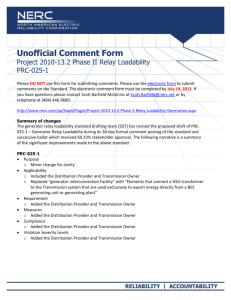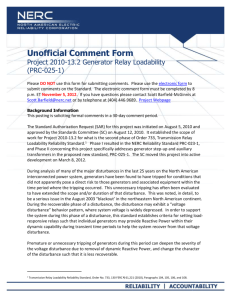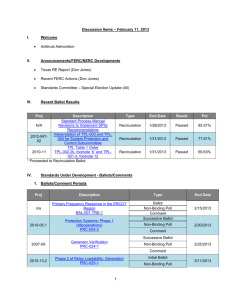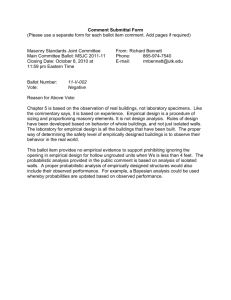Discussion Items – May 20, 2013 I. Welcome Antitrust Admonition II
advertisement
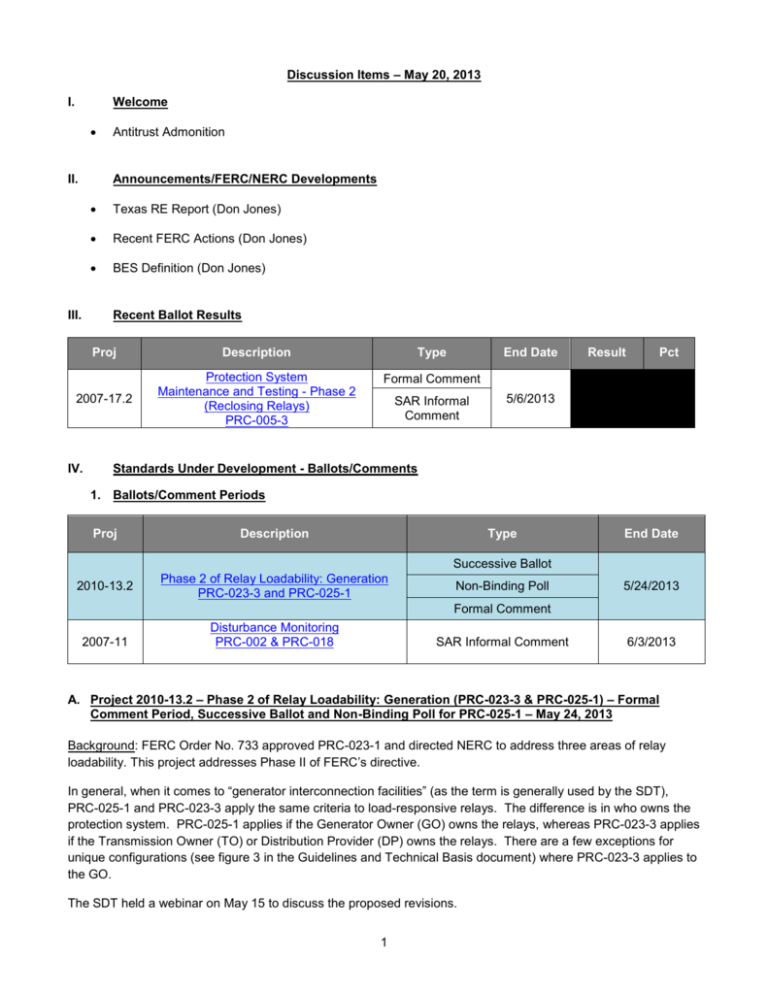
Discussion Items – May 20, 2013 I. Welcome II. Antitrust Admonition Announcements/FERC/NERC Developments III. Texas RE Report (Don Jones) Recent FERC Actions (Don Jones) BES Definition (Don Jones) Recent Ballot Results Proj Description Type Formal Comment 2007-17.2 Protection System Maintenance and Testing - Phase 2 (Reclosing Relays) PRC-005-3 IV. End Date SAR Informal Comment 5/6/2013 Result Pct Passed 67% 73% Standards Under Development - Ballots/Comments 1. Ballots/Comment Periods Proj Description Type 2010-13.2 Phase 2 of Relay Loadability: Generation PRC-023-3 and PRC-025-1 End Date Successive Ballot Non-Binding Poll 5/24/2013 Formal Comment 2007-11 Disturbance Monitoring PRC-002 & PRC-018 SAR Informal Comment 6/3/2013 A. Project 2010-13.2 – Phase 2 of Relay Loadability: Generation (PRC-023-3 & PRC-025-1) – Formal Comment Period, Successive Ballot and Non-Binding Poll for PRC-025-1 – May 24, 2013 Background: FERC Order No. 733 approved PRC-023-1 and directed NERC to address three areas of relay loadability. This project addresses Phase II of FERC’s directive. In general, when it comes to “generator interconnection facilities” (as the term is generally used by the SDT), PRC-025-1 and PRC-023-3 apply the same criteria to load-responsive relays. The difference is in who owns the protection system. PRC-025-1 applies if the Generator Owner (GO) owns the relays, whereas PRC-023-3 applies if the Transmission Owner (TO) or Distribution Provider (DP) owns the relays. There are a few exceptions for unique configurations (see figure 3 in the Guidelines and Technical Basis document) where PRC-023-3 applies to the GO. The SDT held a webinar on May 15 to discuss the proposed revisions. 1 PRC-025-1 received 54.65% stakeholder approval in its initial ballot that closed on March 11, 2013. The SDT previously posted PRC-023-3 for comment with the SAR. Both standards have been revised as a result of comments received. PRC-025-1 is out for successive ballot and comment. PRC-023-3 is out for comment only. Note: This is also the project that was the pilot for the Cost Effectiveness Analysis (CEA). The resulting report has not yet been released. Summary of Changes PRC-025-1 Purpose o Revised to remove the first occurrence of “generator” o Other minor revisions to provide clarity in the scope of the standard Applicability o Inserted section 3.2.5 to provide applicability to Facilities that address Elements utilized in the aggregation of dispersed power producing resources. Requirements – No change Attachment 1 o General text revisions o Included language to note that the standard does not require the use of any of the protective functions list in Table 1, Relay Loadability Evaluation Criteria o Removed the Planning Coordinator and inserted the Regional Reliability Organization to comport with the anticipated retirement of MOD-024-1 and MOD-025-1 and the approval of MOD-025-2 in both the text and Table 1 o Inserted language to address situations where the Generator Owner may combine both asynchronous and synchronous generators on a generator interconnection Facility to provide direction on the evaluation of relay loadability o Update the references to no-load tap changes (NLTC) and on-load tap changers (OLTC) to the generally accepted use of the IEEE terms, deenergized tap changers (DETC) and load tap changers (LTC) o Added an exception to the standard for Protection Systems that detect generator overloads o Added an exception to the standard for Protection Systems that detect transformer overloads o Made minor editorial edits to Table 1 text for clarity such as replacing “connected to” with “aggregate” for consistency with other uses o Made minor editorial edits to remove hyphens and inserting the word “connected” (e.g., Generator step-up transformer [connected] to asynchronous generators) o For the application of generator interconnection Facility, reduced the Reactive Power output calculation from 150% to 120% for consistency with the previous PRC-023-2, Requirement R1, Criterion 6 PRC-023-3 Applicability o The phase “at the terminal of the” was inserted in for each applicable entity of the standard to create a bright light between the proposed PRC-023-3 and PRC-025-1 standards 2 o References to the two new Requirements (R7 and R8) was inserted for the applicable Distribution Provider and Transmission Owner o References to the two new Applicability for Circuits (4.2.3 and 4.24) were inserted for the applicable Distribution Provider and Transmission Owner o Applicability 4.2.3 – Circuits Subject to Requirement R7 was added to create a bright line between the proposed PRC-023-3 and PRC-025-1 standards for the Distribution Provider and Transmission Owner regarding generator interconnection Facilities o Applicability 4.2.4 – Circuits Subject to Requirement R8 was added to create a bright line between the proposed PRC-023-3 and PRC-025-1 standards for the Distribution Provider and Transmission Owner regarding generator step-up (GSU) transformers Requirements o Requirement R1, Criterion 6 was removed and replaced by two new proposed Requirements R7 and R8 o New Requirement R7 applicable to the Distribution Provider and Transmission Owner regarding generator interconnection Facilities to create a bright line between the proposed PRC-023-3 and PRC-025-1 in applying settings to load-responsive protective relay for loadability o New Requirement R8 applicable to the Distribution Provider and Transmission Owner regarding generator step-up (GSU) transformer to create a bright line between the proposed PRC-023-3 and PRC-025-1 in applying settings to load-responsive protective relay for loadability. Attachment A o Revised criterion 2.4 to address relays applied at the terminals of generation Facilities in accordance with NERC Reliability Standard PRC-025-1 for the Planning Coordinator pursuant to Requirement R6 Attachment C o Inserted new attachment to address relay loadability described in Requirements R7 and R8 o Includes Table 1, Relay Loadability Evaluation Criteria which is the same as the criteria proposed in PRC-025-1 for generator interconnection Facilities and generator step-up (GSU) transformers Industry Discussion B. Project 2007-11 Disturbance Monitoring – Revised SAR Informal Comment Period – June 3, 2013 Background: This project was initiated to address an existing “fill in the blank” standard. FERC did not approve or remand PRC-002-1 in Order 693 because the standard contained requirements that applied to the Regional Reliability Organization and did not specifically identify performance requirements for registered entities. FERC did approve PRC-018-1 in Order 693. Similar to PRC-002-1, PRC-018-1 contained Regional Reliability Organization requirements, but FERC stated that the requirements are clear enough to be enforced. This project intends to address FERC concerns in Order 693, specifically the “fill in the blank” aspects in both standards. A SAR to initiate the project was initially posted in 2007 with a scope of reviewing both standards and merging them into one replacement standard. A standard drafting team was appointed by the Standards Committee in 2007, who drafted PRC-002-2, which proceeded through an initial ballot period. In 2010 the Standards Committee decided to prioritize its work, which resulted in moving Project 2007-11 Disturbance Monitoring to informal development. In its 2013 work plan, the Standards Committee changed the status to formal development as part of the effort to address pending projects. The drafting team revised the SAR to focus the project on a results-based approach to the capture of data, instead of prescriptive requirements on equipment necessary to capture the data. The drafting team believed that 3 it was best to describe the performance requirements (using a risk-based approach) rather than prescribing necessary equipment. Also, the Reliability Coordinator and Planning Coordinator were added as applicable entities to ensure that the responsibility for specifying and collecting needed disturbance data can be appropriately assigned. An industry webinar is scheduled for May 22, 2013 and workshops are tentatively scheduled for the last week of July and the first week of August. The locations for the workshops have not yet been determined. Industry Discussion V. Informal Development Projects As a part of the 2013 work plan, an informal effort is currently underway to support the resolution of FERC directives. The informal efforts will support transition to a formal standards development project, which will include the formal comment and ballot processes that have always occurred. In the specific area of FERC directives, the possible ways to resolve a directive may be to (i) implement the directive as stated, (ii) provide a solution that offers an equally efficient and effective method of addressing the concern, or (iii) providing justification why the directive has been overcome by events and is no longer needed. There are currently 5 informal development efforts ongoing: MOD A (ATC, TTC, CBM): MOD-001, -004, -008, -028, -029 & -030 – Ryan Stewart o These standards are not applicable in the ERCOT region MOD B (modeling data): MOD-010 through MOD-015 – Steve Noess o Draft documents circulated to interested parties on MODB distribution list o Consolidating 6 standards into 2: model data (steady-state, dynamic, short circuit) & model validation (PC/RC applicability only) o May 9 Technical Conference briefing (Larisa Loyferman, CenterPoint Energy) MOD C (demand data): MOD-016 through MOD-021 – Darrel Richardson o No known activity to date (Norm Muraya, Austin Energy) PER (Training): PER-002 and PER-005 – Jordan Mallory o Ad hoc group continues to meet; on schedule for May/June Posting (Jim Bowles, ERCOT) o Informal Development Survey conducted May 13 – 17 o May 31 Webinar scheduled VAR: VAR-001 and VAR-002 – Soo Jin Kim o Technical Conference briefing provided on 5/6 NSRS call (Mike Cruz-Montes, CenterPoint Energy) VI. 5-Year Review Projects NERC Standards Committee appointed review teams a few weeks ago Project 2012‐13 NUC Review o Luminant representative on the review team Project 2012‐09 IRO Review Project 2009‐03 Emergency Operations o Jen Fiegel (Oncor) on the review team o Jen to provide an update on the May 8 review team meeting 4 VII. Project 2010‐02 Connecting New Facilities to the Grid/FAC Review o Luminant representative on the review team Compliance Application Notices (no new information) Remaining CANS can be found here: http://www.nerc.com/page.php?cid=3|22|354 VIII. Violations – 4/30/13 (no new information) Region Entity Amount Standards NERC as CEA Unidentified RE $40,000 CIP-007-1 Texas RE Brownsville Public Utility Board $10,000 EOP-003-1 See also, Spreadsheet NOPs (18 registered entities a total of ~$400,000 for 80 violations of 18 Reliability Standards; $82,400 for “693” standards and $315,250 for “706” standards) See also, FFTR Spreadsheet (resolves 75 possible violations of 20 Reliability Standards affecting 50 registered entities) IX. Projected Postings (excerpt from Standards Committee Meeting Agenda May 2, 2013) Yellow highlights indicate projects not yet posted but the projected date has passed. That is, expect to see it soon. To be posted during the week of May 13: o Project 2007-02 Operating Personnel Communication Protocols – COM-003-1 (30-day comment period and successive ballot) To be posted during the week of May 20: o Project 2010-14.1 BARC: BAL-001-1, BAL-002-2, BAL-013-1 (30-day comment period and successive ballot) o Project 2010-05.1 Protection Systems: Phase 1 (Misoperations) – PRC-004-3 (30-day comment period and successive ballot) To be posted during the week of May 27: o Project 2010-17 Definition of Bulk Electric System: Guidance Document – Phase 1 (for information only) To be posted during the week of June 3: o Project 2007-06 System Protection Coordination – PRC-027-1 and PRC-001-3 (30-day comment period and successive ballot) To be posted during the week of June 10: o Project 2007-17.2 Protection System Maintenance and Testing – Phase 2: Reclosing Relays (45-day comment period and initial ballot) o MOD A SAR: Available Transfer Capability, Total Transfer Capabilities, and Capacity Benefit Margin (30day informal comment period) o MOD C SAR: Demand Data (30-day informal comment period) o PER SAR: Training (30-day informal comment period) o VAR SAR: Reactive Resources (30-day informal comment period) To be posted during the week of June 17: o Project 2010-13.2 Generator Relay Loadability, PRC-025 (possible recirculation ballot) o Project 2010-13.2 Generator Relay Loadability, PRC-023 (45-day comment period and initial ballot) To be posted during the week of June 24: 5 o Project 2007-02 Operating Personnel Communication Protocols – COM-003-1 (possible recirculation ballot) NERC has posted the Project Management and Oversight Subcommittee’s standards development project tracking spreadsheet to the Standards Committee page under “Related Files.” The PMOS will use this spreadsheet to track the progress of standards projects and identify issues in support of the timely development and maintenance of standards. It will be updated at least monthly. X. Miscellaneous NERC Webinars o May 22 – Project 2007-11 Disturbance Monitoring – 1-3 pm ET (Webinar Registration) o May 31 – PER Industry Feedback Webinar – 1-3 pm ET (Webinar Registration) NERC is hosting GridSecCon 2013 on October 15-17 in Jacksonville, FL (information) Reliability Assurance Initiative Concept White Papers posted for industry comment (Link to website) XI. Future Meetings May 20 June 3 June 17 June 26, 9am (face-to-face meeting combined with RSC) July 8 July 22 August 5 6
